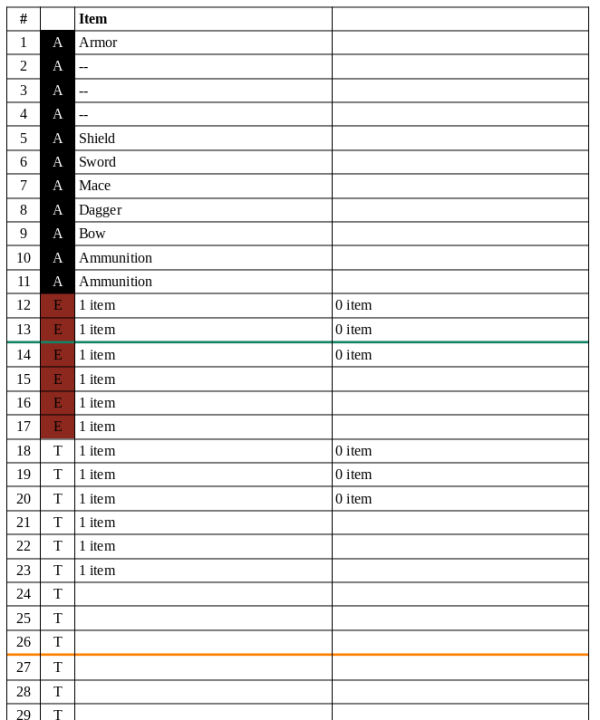 Encumbrance in D&D has always ranged from bad to terrible. The idea behind encumbrance is actually great. The default assumption for the first decade or so had been that the party enters a dangerous place, gets their hands on valuable stuff, and gets back out again, preferably with their loot and without anyone dying. When wandering monsters are a thing (look forward to part 3) and fighting battles is a negligible source of XP (look forward to part 4), then getting in and out quickly is of the essence. The longer it takes you, the greater is the risk of anyone dying with no benefit in trade. So as you keep delving deeper into the dark unknown, you are using up some of the tools and supplies you have brought with you, but at the same time get weighted down by the treasures you find. Which leaves you with two choices. Slow down and risk fighting more opponents and reducing your odds of being able to run away. Or reduce your weight, either by choosing to leave some of the treasure you’ve found behind, or by dropping some of the equipment that you hopefully won’t be needing on your way back to the surface. Hang on to all your potentially life saving tools and weapons as you slowly crawl back to the exit, or make a mad dash to safety? Or play it safe and leave some of your hard fought for rewards behind? This is a real question that players will have to face. There is no right answer which two out of these three you should choose and will greatly depend on the constantly changing situations. To me, this is one of the big things that make exploration adventures so exciting.
Encumbrance in D&D has always ranged from bad to terrible. The idea behind encumbrance is actually great. The default assumption for the first decade or so had been that the party enters a dangerous place, gets their hands on valuable stuff, and gets back out again, preferably with their loot and without anyone dying. When wandering monsters are a thing (look forward to part 3) and fighting battles is a negligible source of XP (look forward to part 4), then getting in and out quickly is of the essence. The longer it takes you, the greater is the risk of anyone dying with no benefit in trade. So as you keep delving deeper into the dark unknown, you are using up some of the tools and supplies you have brought with you, but at the same time get weighted down by the treasures you find. Which leaves you with two choices. Slow down and risk fighting more opponents and reducing your odds of being able to run away. Or reduce your weight, either by choosing to leave some of the treasure you’ve found behind, or by dropping some of the equipment that you hopefully won’t be needing on your way back to the surface. Hang on to all your potentially life saving tools and weapons as you slowly crawl back to the exit, or make a mad dash to safety? Or play it safe and leave some of your hard fought for rewards behind? This is a real question that players will have to face. There is no right answer which two out of these three you should choose and will greatly depend on the constantly changing situations. To me, this is one of the big things that make exploration adventures so exciting.
Random Encounters, XP for treasure, and Encumbrance are really a single unified system. They really only work together as a unit. When you ditch one of them, the other two stop serving any purpose as well. And I think most of the time, Encumbrance is the first one to go. Because the way D&D handles it is just so annoyingly tedious that almost everyone very quickly, if not immediately, decides to just not bother with it at all. Whether you calculate your character’s equipment load in pounds or in coins, every time you pick up an item or drop an item, you have to adjust your current encumbrance load value. And inevitably you will sometimes forget it or make mistakes, requiring to make a complete recount of all your inventory and calculate all the different weight again. Nobody thinks that’s fun. To really do that, you need to keep your inventory on spreadsheets, and playing the game with everyone having a computer open can’t be the way to go. So out the window Encumbrance goes, making the whole exploration system pointless.
But there is a solution, and it is brilliant in its simplicity. It also isn’t mine. This idea is taken pretty much straight from Papers and Pencils. I don’t really add anything significant to it, I am just aligning it with my exploration system here. What this system does is to say “calculating loads by weight doesn’t work because nobody uses it, let’s drop the idea of doing it ‘realistically’ and use a much simpler system of inventory slots”. Yes, it’s a greater degree of abstraction, but as I always keep saying all of the numbers in these mechanics are make believe anyway, and a system that people would want to use is always better than a system that always gets ignored.
The basic, and really very simple idea is that any items have a weight that is either “insignificant”, “significant”, or “especially heavy”. Insignificant weight means the item has an encumbrance value of 0, significant weight means it has an encumbrance value of 1, and especially heavy items have an encumbrance value of 2 or higher. To assign an encumbrance value to an item, my rule of thumb is round up the weight in pounds to the nearest multiple of 10, then drop the last 0. Items with a weight below 1 pound have an encumbrance value of 0.
The amount of items a character can carry is as follows:
| Speed | Max. Load | Effect |
|---|---|---|
| Unencumbered | STR x 1 | — |
| Encumbered | STR x 2 | Speed -10 |
| Heavily Encumbered | STR x 3 | Speed -20, disadvantage to Str, Dex, and Con |
And that is the entire system. But you can even simplify this even more by setting up your inventory sheet in the right way. I recommend making a dedicated inventory sheet like this, but you can try squeezing it into the inventory space on your character sheet.

There are two columns for items. One for items with significant weights that add to encumbrance, and one for items with insignificant weights that don’t. On the left side you have all the rows numbered. When you now put all your items with significant weights into the left item column, and make them take up as many lines as its the encumbrance value, you no longer have to calculate anything. Your current load value is right there to the left of the last item on your list. To make things even easier for you, you can mark the lines that match your Strength score times 10, 20, and 30. In this example, the character has a Strength score of 13, so he is unencumbered with a load up to 13, encumbered with a load up to 26, and heavily encumbered with a load up to 39. The line below 13 items is marked green here, the line below 26 items marked orange. When you add or remove items on your inventory list, you immediately see when your current encumbrance category changes. The column with the items of insignificant wight doesn’t matter, I just thought it fits conveniently in the place where it is here.
Next to the numbers, I added another column as a recently added new feature. In this column you can mark if the items are part of your Arms, Exploration Gear, or Travel Gear. If you keep them sorted like this, it becomes trivial to say “I put down the backpack with my heavy travel gear and continue forward with only my arms and my tool pouch”. Again, no new calculations are needed. In this example we immediately see that the Arms and Exploration Gear cross below the green line, but stay above the orange line. That means when I drop my backpack with my tent, food, and spare clothing, my encumbrance will be Encumbered.
I did play around a bit with an idea of keeping track of various pouches and sacks characters might be carrying, but that just ends up disrupting the neat simplicity and easy of use of this system. So again, I just said eh!, and went for the more abstract option that requires the least amount of bookkeeping and rearranging your inventory. Though I admit I still don’t have a perfect idea what to do when characters go into a dungeon with empty space in their Exploration Gear pouch that later gets filled with treasure that they pick up. Right now, this still requires you to move an item from the top of your T-items to the bottom and adding the new item as an E-item. Maybe this can be improved as well, but I think so far this is a really damn good inventory management system, far better than anything you find in almost all versions of D&D.
